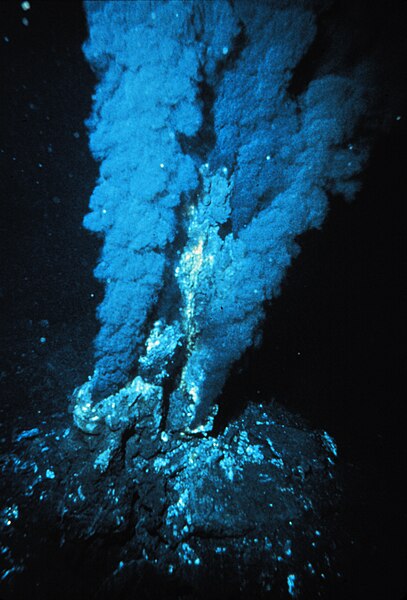As a source of gold volcanogenic massive sulfides are not the primary source, but they do contain a substantial amount of gold as a byproduct. These deposits also hold significant amounts of copper, lead, zinc as well as gold and silver. Throughout history the VMS deposits are generally not the first choice of miners, as they are usually small and can be difficult to process. In today's world they have become a more significant source of metals than they were in the past because of advances in technology as well as the recent high metal prices that have caught the attention of prospectors.
 |
| This is Rouyn-Noranda the home of a VMS deposit. The Horne Smelter is in the background. |
Deposits of VMS minerals can take in a variety of shapes occurring typically as lenses of polymetallic massive sulfide subform in patches on the seafloor near black smokers. Deposits of this nature can be found in extensional tectonic settings that include both spreading from the tectonic ridge, or can also be found in back arc basins such as the modern Sea of Japan . They range in age from some of the oldest rocks on Earth to the modern black smokers that are found in oceanic spreading centers.
Many deposits of this type that were once on the ocean floor have been incorporated in the continental crust by tectonic earth movements, so they are now on land. Even with the location of many of these deposits on dry land there are still many other exploration and mining companies that are interested in recovering minerals from the seafloor VMS deposits.
 |
| A black smoker where VMSs are formed in the Atlantic Ocean |
Deposits of the VMS type are grouped according to the type of rock they are hosted in or on the basis of ore composition. This type of deposits can be classified in three different ways.
1. These are felsic volcanic hosted making up the most popular category that accounts for at least 50% of the deposits. Examples of this type of deposits can be found in the Abitibi region of Canada Ontario
2. These are mafic volcanic hosted accounting for about 30% of the deposits,
3. These are interbedded with a mixed bag of volcanic and sedimentary rocks that account for an additional 20% of VMS deposits.
The ore found in these deposits is broken into two groups: copper, zinc and zinc, lead and copper they also contain significant amounts of gold and silver.

No comments:
Post a Comment